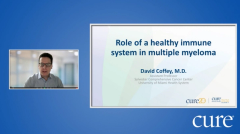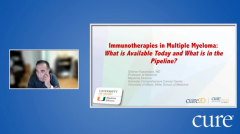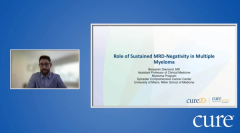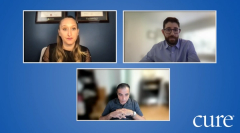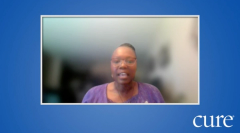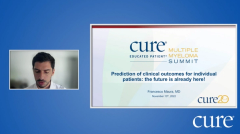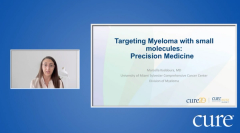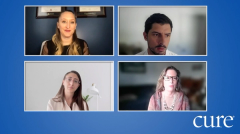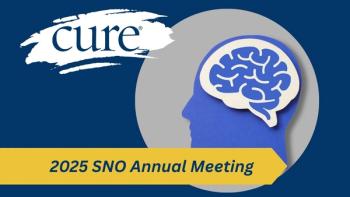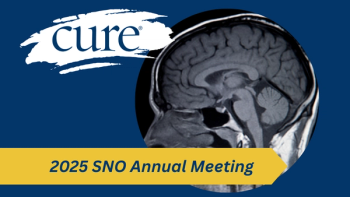
Educated Patient® Multiple Myeloma Summit Novel Treatments for the Newly Diagnosed Presentation: November 13, 2022
Watch Dr. C. Ola Landgren, from Sylvester Comprehensive Cancer Center at the University of Miami, discuss novel treatments for newly diagnosed patients during the CURE® Educated Patient® Multiple Myeloma Summit.
Episodes in this series

Over recent years, immunotherapy has created a new era for patients with multiple myeloma, helping to increase life expectancy with these new agents and combination regimens, according to Dr. Ola Landgren.
At the CURE® Educated Patient® Multiple Myeloma Summit, Landgren, chief of the Myeloma Division and leader of translational and clinical oncology at the Sylvester Comprehensive Cancer Center, University of Miami, who also served as the summit chair, shared the history of treatment for myeloma – from the 1950s to present day as well as the future. In particular, he focused on three distinct eras of treatment: the bygone palliative era, the chemotherapy era and the currently-used immunotherapy era.
Past and Present Treatments of Myeloma
Initially, there were no real treatment options for patients with multiple myeloma. As a result, rather than treat the disease, palliative care was used to manage the symptoms instead.
With the advent of high-dose Evomela (melphalan) in 1983 and the first bone marrow transplant study, the chemotherapy era began. In addition, this period of time classified patients into two groups: transplant-eligible or -ineligible.
In 2015, the year when the immunotherapy era began, according to Landgren, the monoclonal antibodies Empliciti (elotuzumab) and Darzalex (daratumumab) were approved for the treatment of multiple myeloma. Since, the introduction of chimeric antigen receptor (CAR)-T cell therapies has added yet another option for a certain patients with myeloma.
As treatments have continued to evolve, the field has shifted from prioritizing overall survival (the time from treatment that a patient is alive) as a primary focus in clinical trial outcomes, to an emphasis on progression-free survival (the time from treatment to disease worsening). This was a result of immunotherapy demonstrating negative impacts when utilized with bone marrow transplants; however, a shift in focus helped to improve the agents and their outcomes, regardless of a patient’s transplant eligibility status.
The Future of Myeloma
Landgren predicted that in the next two years as many as 10 new immunotherapy treatments could be evaluated and/or approved for multiple myeloma, which would vastly increase freedom of choice for patients and providers and, hopefully, improve life expectancy as well. He compared his vision of the future to the strides made in the treatment of human immunodeficiency virus (HIV).
“HIV used to be a very detrimental diagnosis. But today, individuals with HIV have the same exact lifespan as the general population; the difference being that they still have to be on therapy. Ultimately, I hope we will be able to develop a complete cure for patients with myeloma,” he said.
Patients will also benefit from a clinical pivot to whole-genome sequencing, instead of the current practice of looking only at previously established high-risk markers. Whole-genome sequencing allows physicians to identify chromothripsis (a mutational process characterized by massive, clustered genomic rearrangements) and the family of proteins known as APOBEC, which Landgren believes will “change the field.” He also highlighted the importance of minimal residual disease (MRD), which means that myeloma cells are still present in bone marrow but the patient has achieved a complete clinical response, or remission, and the role it will play in the long-term care of myeloma – which can now be considered a chronic disease.
As the needle continues to move forward, however, Landgren concluded that questions still remain in the treatment of multiple myeloma. “If four drugs are better than three, will five be even better? Can we start removing drugs? Can MRD negativity identify patients who can stop therapy? Can transplant be delayed for the so-called transplant-eligible patients? Can early progressors be identified? Can long term toxicities be predicted?,” he questioned.
“These are important questions and there are many more.…Earlier initiation of therapy, a large pipeline of immunotherapy with chemotherapy-free combinations (and) blood-based MRD testing will probably change everything. And I think there will be a lot of MRD-driven treatment strategies in every clinic, every day; those are my predictions going forward.”
For more news on cancer updates, research and education, don’t forget to

